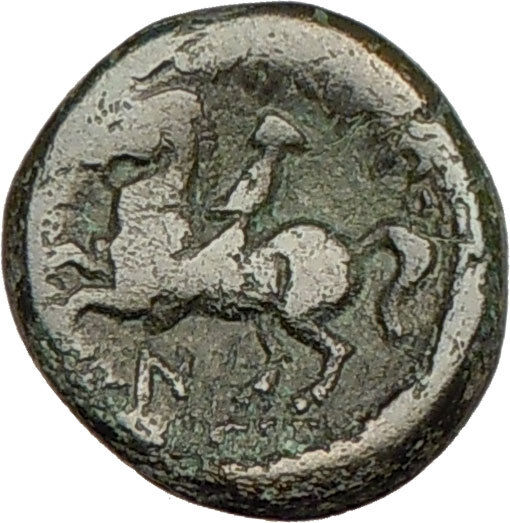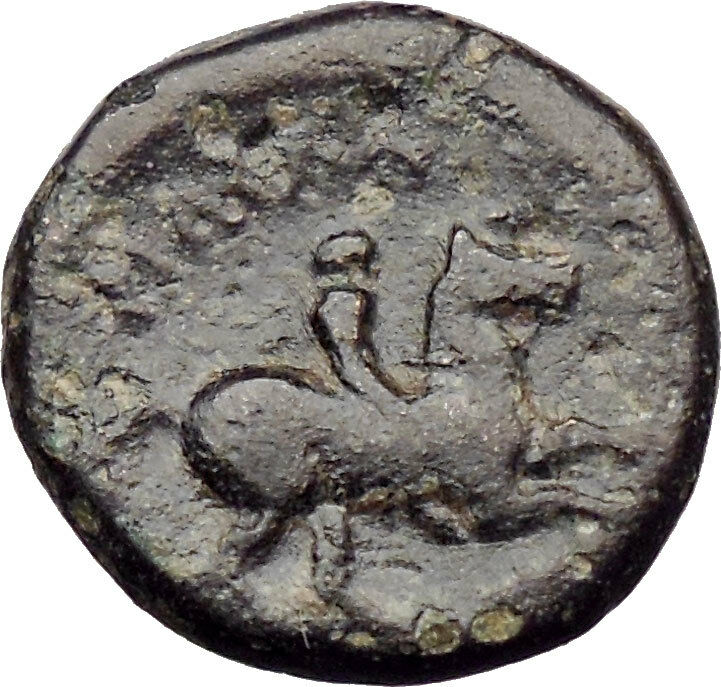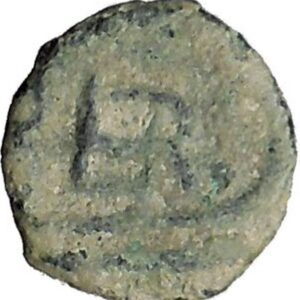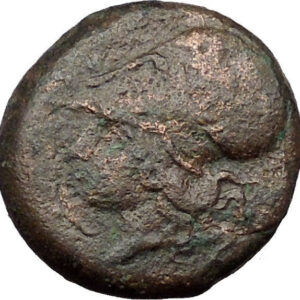|
Alexander III, the Great: Macedonian Greek
King: 336-323 B.C.
Roman Era, Olympic-Style Games Issue
Bronze 26mm (12.81 grams) from the Koinon of Macedonia in Thrace
under Roman Control
Struck circa 222-235 A.D. under the reign of Roman Emperor Severus
Alexander
AΛЄΞANΔPOV,
Head of Alexander the Great as Hercules right, wearing the lion-skin headdress.
KOINON MAKЄΔONΩN NEΩ, Alexander the Great on his legendary
horse, Bucephalus, charging right with cape flying behind him.
* Numismatic Note: Leaders like Julius Caesar and the Romans
and the Greeks alike had immense respect for the great accomplishments of
Alexander the Great. Macedonia, being the kingdom of Alexander the Great’s
birth, this coin featuring his likeness heralds the Neocorate status of the
area, along with the Olympic-style games that accompanied it. Highly-coveted
type.
You are bidding on the exact item pictured,
provided with a Certificate of Authenticity and Lifetime Guarantee of
Authenticity.
The provincial coinage issued in the name of a district council (KOINON) was not
very common at the time of Augustus and the formation of provincial Roman
governments. Most cities issued coinage in their own names – either as
autonomous or as individual subjects of the emperor or a client king. In fact,
the koina never became very widespread in practice or authority. From
inscriptions on provincial coins, we know of koina in Macedon and Thessaly in
Greece – also on the islands of Lesbos, Crete and Cyprus. The remainder were
from the East.
In theory, the koinon may be likened to a federation where representatives of
each city in the district form an assembly with a democratic voice. In practice,
however, they had very limited powers. One of their main functions was the
organization of festivals and games in favor of the imperial cult. The allusion
to these games is normally seen in the legends or iconography of the coins which
they issued. Other typical images are the temple of the koinon or
personifications of the Senate
The koina should not be thought of as independent political powers. They were,
of course, under Roman control. In fact, the Roman proconsul or provincial
governor is sometimes named on these coins.
Neocorus was a Greek title which designated the individual who had charge of
the interior of a temple and looked out for the temple’s needs. In Roman times,
provincial Greek cities often styled themselves as the neocori of the imperial
cult. This was an obvious form of flattery, which insinuated the godliness of
the emperor and indicated the city’s devotion and loyalty. The neocorate of a
city was a great and coveted honor, and not one which was presumed arbitrarily.
The emperor allowed the bestowing of this right only to cities which had earned
the status. Consequently, cities were eager to announce this consideration and
usually did so on their coinage. The proclamation of a neocorate on coins was
often accompanied by a depiction of the temple.
Originally, it was imperial policy that only one neocorate would be allowed in a
city. This rule was later relaxed, and several cities were allowed two or more
neocorates. The subsequent awards were depicted on coins by showing two or three
temples along with an appropriate inscription. The first neocorate of a city was
usually mentioned in the inscription simply as NEΩKOPΩN. The second appeared as
B NEΩKOPΩN, the third as F NEΩKOPΩN (e.g. Pergamum).
The approval of neocorate was usually accompanied by games and festivals. The
coins struck for these events often displayed a combination of neocorate and
agonistic imagery. Like the number of temples depicted, there also seems to be a
correlation between the imagery and the award on some of the “games” issues.
Although this may be coincidental, coins bearing the single NEOKOPOC often have
a singular agonistic crown or urn, which is in the center field between the
temples. Those indicating a second or subsequent neocorate have two or more
crowns.
The iconography of neocorate and agonistic references is very complex and not
fully understood by most numismatists. It is, however, a wonderful area for
study, research and discovery. You may learn more about the interrelationships
between these aspects of religion, civic administration and public events, and
then we will undoubtedly be able to unravel some of the underlying symbology.
Bucephalus or
Bucephalas (Ancient
Greek: Βουκέφαλος or
Βουκεφάλας, from βούς bous, “ox”
and κεφαλή kephalē, “head” meaning
“ox-head”) (c. 355 BC
– June
326 BC
) was
Alexander the Great
‘s
horse
and one of the most famous actual horses
of
antiquity
. Ancient accounts state that
Bucephalus died after the
Battle of the Hydaspes
in
326 BC
, in what is now modern
Pakistan
, and is buried in
Jalalpur Sharif
outside of
Jhelum
,
Pakistan
. Another account states that
Bucephalus is buried in
Phalia
, a town in Pakistan’s
Mandi Bahauddin District
, which is named after
him.

Alexander and Bucephalus in combat at the
battle of Issus
portrayed in the
Alexander Mosaic
Alexander III of Macedon, popularly known to history as Alexander
the Great,
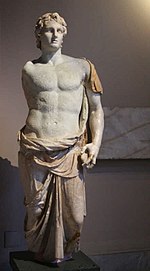
(“Mégas Aléxandros“)
was an
Ancient Greek
king (basileus)
of
Macedon
. Born in 356 BC, Alexander succeeded his father
Philip II of Macedon
to the throne in 336 BC, and died in
Bablyon
in 323 BC at the age of 32.
Alexander was one of the most successful military commanders of all time and
it is presumed that he was undefeated in battle. By the time of his death, he
had conquered the
Achaemenid Persian Empire
, adding it to Macedon’s European territories;
according to some modern writers, this was much of the world then known to the
ancient Greeks (the ‘Ecumene‘).
His father, Philip, had unified most of the
city-states
of mainland Greece under Macedonian
hegemony
in
the
League of Corinth
. As well as inheriting hegemony over the Greeks, Alexander
also inherited the Greeks’ long-running feud with the
Achaemenid Empire
of
Persia
. After reconfirming Macedonian rule by quashing a rebellion of
southern Greek city-states, Alexander launched a short but successful campaign
against Macedon’s northern neighbours. He was then able to turn his attention
towards the east and the Persians. In a
series of campaigns
lasting 10 years, Alexander’s armies repeatedly defeated
the Persians in battle, in the process conquering the entirety of the Empire. He
then, following his desire to reach the ‘ends of the world and the Great Outer
Sea’, invaded India, but was eventually forced to turn back by the near-mutiny
of his troops.
Alexander died after twelve years of constant military campaigning, possibly
a result of malaria
, poisoning
,
typhoid fever
, viral
encephalitis
or the consequences of alcoholism. His legacy and conquests
lived on long after him and ushered in centuries of Greek settlement and
cultural influence over distant areas. This period is known as the
Hellenistic period
, which featured a combination of
Greek
,
Middle
Eastern
and
Indian culture
. Alexander himself featured prominently in the history and
myth of both Greek and non-Greek cultures. His exploits inspired a literary
tradition in which he appeared as a legendary
hero in the
tradition of Achilles
.

Alexander fighting Persian king Darius III. From Alexander
Mosaic, from Pompeii, Naples, Naples National
|








